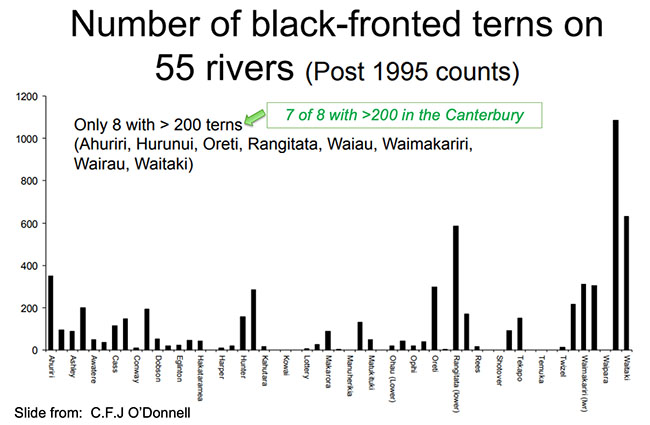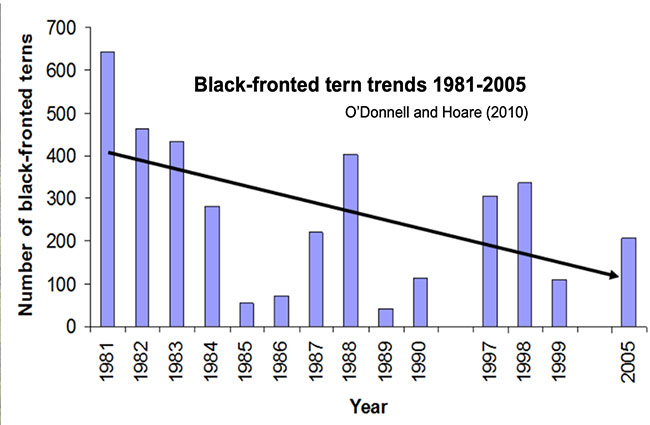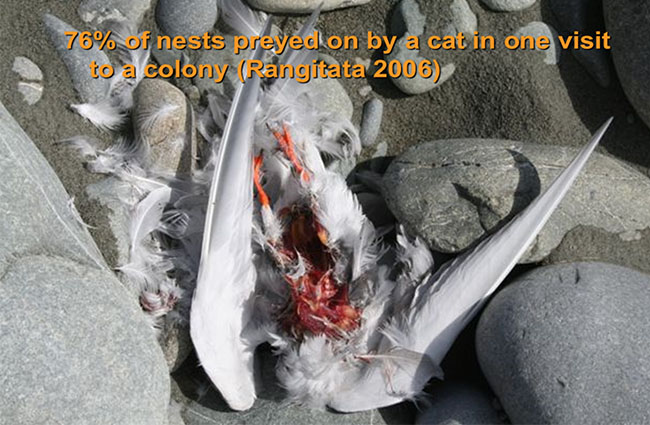Black-fronted tern | tarapirohe
Status: Nationally Endangered
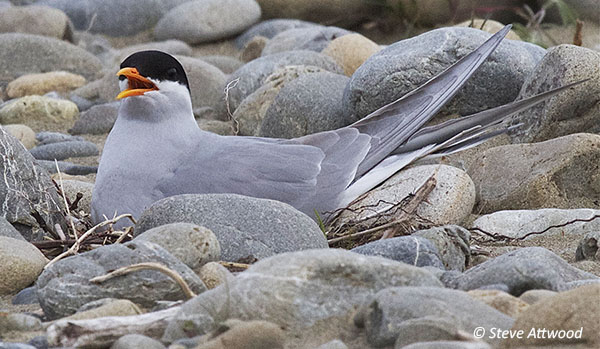
The black-fronted tern | tarapirohe is seen from the southern tip of the North Island, and along much of the eastern South Island from Marlborough to Southland and to Stewart Island. There is an outlying population along the Buller and upper Motueka Rivers in southern Nelson. The breeding range is restricted to the South Island. While most terns are seabirds, the black-fronted tern black-fronted tern | tarapirohe lives and breeds inland along riverbanks and can forage out to 10 km at sea in the non-breeding season in autumn and winter.
Description
The black-fronted tern (Chlidonias albostriatus) also known as the riverbed tern or tarapiroe (Māori), is a medium to small tern endemic (unique) to New Zealand, measuring 28-29cm and weighing 95grams. It is unique amongst terns in that it is the only one to breed exclusively inland. They nest in colonies on open shingle or small islands in the river.
Predominantly grey plumage over most of the body with black cap extending down over the eyes to the bright red-orange beak. During the non-breeding season the black cap recedes from the bill and becomes flecked with white. The underparts and rump are white, and there is a thin white streak running along the cheeks underneath the cap. The legs are orange.
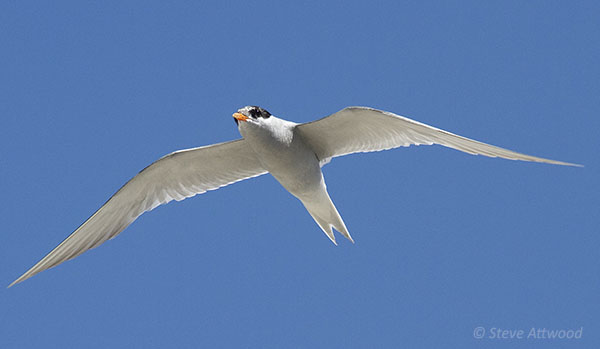
Population trends
black-fronted tern | tarapirohe evolved to breed on weed-free shingle islands and banks on braided rivers. Their numbers have been declining rapidly for reasonably well-understood reasons outlined here.
Conservation efforts
Field research on key rivers has led to multiple projects, many ongoing, to determine the causes and best practices needed required to reverse the decline in population. As each river is different, often hosting different predator guilds, a one-size-fits-all approach to management is not possible. Nevertheless, lessons learned from each river and ongoing research is helping to create a suite of management options. The following summarises these efforts on different rivers.
Waiau Toa / Clarence River: Over five years more than $500,000 was spent around the three breeding colonies of black-fronted tern | tarapirohe on conservation land neighbouring Molesworth Station between Jacks Pass and the Acheron River. Follow-up projects have improved the breeding success (videos 1 and 2). See also:
- 2023 Waiau Toa/Clarence and Wakaputawatea/Acheron River tarapirohe/black-fronted tern monitoring project – 2022/23 operational report (WMIL).
- 2022 Waiau/Toa Clarence River black-fronted tern monitoring project 2021/2022 operational report (WMIL)
- 2022: Breeding movements of black-fronted terns/tarapirohe (Chlidonias albostriatus) caught on the Waiau Toa/Clarence River during the 2021 breeding season (report)
- 2022: The shifting frontlines of tarapirohe/black-fronted tern conservation (PDF of Braided Rivers seminar presentation; see also Videos 1 and 2)
- 2022: Island enhancement on the Waiau Toa-Clarence River
- 2019-2020 (final) report
- 2017-2018 report
- 2016-2017 report
Upper Rangitata River
- 2019-2020 (DOC): Trapping Project
- 2016-2017 (DOC): Wrybill and Black Fronted Tern Nesting Success
Lower Waitaki River: this island-creation project was initially setup as part of a doctoral dissertation, with follow up work ongoing. Video 4 is a drone flight over the research area.
- 2020: Five year report: Lower Waitaki River island enhancement project for black-fronted tern 2015-2020
- 2018: Schlesselman (PhD thesis); Linking science and management for effective long-term conservation: A case study of black-fronted terns/tarapirohe (Chlidonias albostriatus).
- 2016: Video: showing egg resiliency even when river floods & submerges them for several hours
- 2015: Video: impact a stoat has on a nesting black-fronted tern
- 2023 (Braided Rivers Seminar presentation PDF): A tern of events: Outcomes from recent changes to management on Project River Recovery’s Tern Island
- 2022 (Braided Rivers Seminar presentation PDF): Breeding movements and winter dispersal of black-fronted terns (Chlidonias albostriatus) Video 6 is a recording of the presentation
More information
- NZ Birds online (includes photos, sounds)
- iNaturalist
- Birdlife International (includes Google distribution map)
- NZ Birds
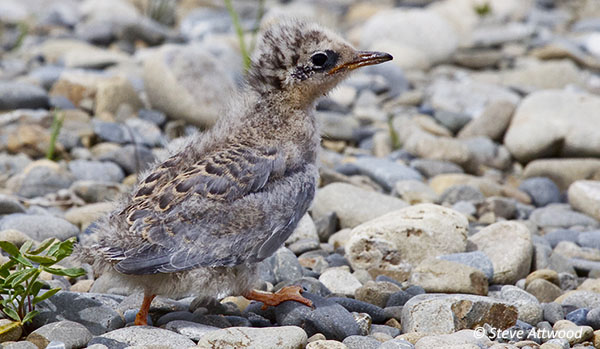
Research and references
- 2022: Bell & McCool; Rakaia River Black-fronted tern monitoring 2021-2022, report for Boffa Miskell.
- 2022: Schlesselmann et al; New Zealand endemic open-habitat specialist, the Black-fronted Tern (Chlidonias albostriatus), experienced population expansion during Pleistocene glaciation and recent decline, Ibis, 11 July.
- 2022: Connor and McClean et al; Waiau/Toa Clarence River black-fronted tern monitoring project 2021/2022 operational report WMIL
- 2022: Williams & Krause; Breeding movements of black-fronted terns/tarapirohe (Chlidonias albostriatus) caught on the Waiau Toa/Clarence River during the 2021 breeding season (report)
- 2021: Mayence, Incorporating food web research into a braided river adaptive management project: overview of the next five years on the Waiau Toa/Clarence River Braided Rivers Seminar presentation
- 2020: Lewis & Maloney; Five-year report: Lower Waitaki River island enhancement project for black-fronted tern 2015-2020 (DOC)
- 2020: Schlesselmann & Robertson; Longevity can mask low Nb if only Ne of mixed‑age samples is estimated in threatened and mobile species, Conservation Genetics
- 2019: Black-backed gull control on the Hurunui and Waiau Rivers
- 2019: Hamblin et al; Social attractants, a conservation tool for black-fronted terns. Wildlife Society Bulletin 43 | 3 pp468-475
- 2019: Schlesselmann et al; Contrasting patterns of population structure at large and fine geographical scales in a migratory avian disturbance specialist of braided river ecosystems, Diversity and Distributions, 01 October 2019
- 2018: Schlesselmann, A. Linking science and management for effective long-term conservation: A case study of black-fronted terns/tarapirohe (Chlidonias albostriatus) Thesis, Doctor of Philosophy: University of Otago. NOTE: includes extensive literature review for further research
- 2018: Schlesselmann, A. et al; Clearing islands as refugia for black-fronted terns, New Zealand Journal of Ecology 42: 2
- 2017: Hamblin; Colony dynamics and social attraction in black-fronted terns, Chlidonias albostriatus, Masters Thesis, Lincoln University
- 2017: Hamblin; The use of social attractants as a management tool for black-fronted terns (Braid seminar)
- 2017: Bell; Population size, breeding success and predators of black-fronted tern (Chlidonias albostriatus) in the Upper Clarence River catchment, New Zealand Notornis, 2017, 64: 154-161
- 2016: Bell; Black-fronted tern project on the Upper Clarence: predator ID, predator control, and breeding success (BRaid workshop)
- 2016: Edwards (DOC); Upper Rangitata predator control programme and results (Braid workshop)
- 2016: Hamblin; Responses of black-fronted terns to social attractants (BRaid workshop)
- 2016: Langlands; Post breeding records of SBBG, black-billed gull, black-fronted and white-fronted terns at Canterbury River-mouths 2008 – 2015 (BRaid workshop)
- 2011: O’Donnell, C.F.J., Hoare, J.M. Meta-analysis of status and trends in breeding populations of black-fronted terns (Chlidonias albostriatus) 1962-2008 New Zealand Journal of Ecology 35: 32-43
- O’Donnell Powerpoint presentation: Black-fronted tern population trends and foraging research (DOC)
- See also Ecology/further information and references

